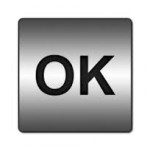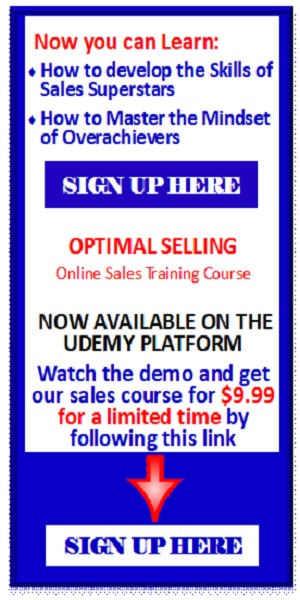 Raising a prospect’s expectations too high can lead to disappointment and create a hole you have to dig yourself out of. This 1 minute video explains how many salespeople set themselves up to fail with one small statement and create problems that put them on the defensive. Eliminating this one phrase can make your presentations be accepted more readily.
Raising a prospect’s expectations too high can lead to disappointment and create a hole you have to dig yourself out of. This 1 minute video explains how many salespeople set themselves up to fail with one small statement and create problems that put them on the defensive. Eliminating this one phrase can make your presentations be accepted more readily.
Don’t tell prospects what to love!
Breaking the ice – it’s not like your high school dance
 High school dances were painful … should I ask her to dance? … What should I say? … I hope he asks me … what should I say? … how should I act? Networking events for some feel a lot like that. But breaking the ice is much easier than high school. Watch this 1 minute 50 second video and discover how to do it.
High school dances were painful … should I ask her to dance? … What should I say? … I hope he asks me … what should I say? … how should I act? Networking events for some feel a lot like that. But breaking the ice is much easier than high school. Watch this 1 minute 50 second video and discover how to do it.
Rejection is like Scotch Whiskey
 Rejection, like your first taste of Scotch is distasteful (At least is was for me). My friends who drink scotch assure me that you have to develop a taste for it. The same is true for rejection. You don’t have to like rejection. And if you realize that they are not rejecting you but only the opportunity to buy and use your product or service then it goes down much smoother.
Rejection, like your first taste of Scotch is distasteful (At least is was for me). My friends who drink scotch assure me that you have to develop a taste for it. The same is true for rejection. You don’t have to like rejection. And if you realize that they are not rejecting you but only the opportunity to buy and use your product or service then it goes down much smoother.
It is always ok to ask
 It’s always OK to ask a question of a prospect. AS LONG AS you keep it in the area of business. Fear of asking questions is related to a fear of rejection or a need for approval. Salespeople who fear asking questions are afraid of looking too pushy or of not knowing something they should have known. If you are not sure if it is ok to ask this video gives you a really simple (and cool) way to find out. the technique only takes about 4 seconds and the answer as to whether it is OK to ask or not comes from a very authoritative source. I made a list of 17 questions that only top salespeople have the guts to ask. If you click on the link below I will send you the 17 questions along with an offer for a short program on the 3 essential elements of the prospect’s compelling reason to buy. If you are already (or were) a client you can have the the 3 essential elements program free by sending me an email at danc@caramanico.com .
It’s always OK to ask a question of a prospect. AS LONG AS you keep it in the area of business. Fear of asking questions is related to a fear of rejection or a need for approval. Salespeople who fear asking questions are afraid of looking too pushy or of not knowing something they should have known. If you are not sure if it is ok to ask this video gives you a really simple (and cool) way to find out. the technique only takes about 4 seconds and the answer as to whether it is OK to ask or not comes from a very authoritative source. I made a list of 17 questions that only top salespeople have the guts to ask. If you click on the link below I will send you the 17 questions along with an offer for a short program on the 3 essential elements of the prospect’s compelling reason to buy. If you are already (or were) a client you can have the the 3 essential elements program free by sending me an email at danc@caramanico.com .
The Elevator Speech
 The elevator speech must grab the person’s attention in a short amount of time. Its purpose is to convert that attention into a conversation, or at least to give a clear idea of how you help people. People will identify with the problems you solve much quicker than they will with the things that you do. Most salespeople focus too much effort in telling what they do and require the prospect to make the connection. For instance over the years I have met very few early stage CEO’s who think they need sales training but every one has worried about how they could build a salesforce that would take the company to the next level.
The elevator speech must grab the person’s attention in a short amount of time. Its purpose is to convert that attention into a conversation, or at least to give a clear idea of how you help people. People will identify with the problems you solve much quicker than they will with the things that you do. Most salespeople focus too much effort in telling what they do and require the prospect to make the connection. For instance over the years I have met very few early stage CEO’s who think they need sales training but every one has worried about how they could build a salesforce that would take the company to the next level.
Maintain Positive Mental Attitude
Sell Yourself First
 If you don’t believe in your solution, the prospect won’t either. That is why you have to “sell” yourself first. Make sure you 100% believe in your solution to their problem and in your right to ask certain questions. If you have doubts about your own solution, your tonality and body language will convey those doubts to the prospect. If you believe you are asking an inappropriate question, you will convey “don’t answer what I’m asking” by our voice, facial expressions, and body language. Your prospect will listen not to your words but to our visual cues. How can you have the right tonality and body language? Sell yourself. Before approaching any real prospects, convince yourself of the value of your solution. Your body language and voice tonality will be 100% with your words and you will communicate that – “I believe my solution will make a big difference for you!”
If you don’t believe in your solution, the prospect won’t either. That is why you have to “sell” yourself first. Make sure you 100% believe in your solution to their problem and in your right to ask certain questions. If you have doubts about your own solution, your tonality and body language will convey those doubts to the prospect. If you believe you are asking an inappropriate question, you will convey “don’t answer what I’m asking” by our voice, facial expressions, and body language. Your prospect will listen not to your words but to our visual cues. How can you have the right tonality and body language? Sell yourself. Before approaching any real prospects, convince yourself of the value of your solution. Your body language and voice tonality will be 100% with your words and you will communicate that – “I believe my solution will make a big difference for you!”
Seeing Through the Prospect’s Lens

If you really want to have a better understanding of the prospect’s pain, you have to be able to see things from their perspective. That is not necessarily the perspective of a product expert or the perspective of an expert in the field. You need to see how they view the situation. That will entail changing how you look at the problem and how you interpret the facts of the situation. Once you can do that then you can have a better idea of how you can position your product to solve the problem. And you can do it in a way that will make sense to the prospect.
Pain Varies Over Time
 The world is a dynamic place and things change from day to day. Just think about your own company and your own life today compared to last quarter or last year. If your life and your perspective changes so much why would you think that the prospects life and perspective would be any different? When things change in the prospects life, their view of your product and the urgency to make a purchase will also change. When their situation changes, that change will have a major impact on whether you can close the sale and how and when you should close the sale. The fact that the situation can change mandates that you stay abreast of the latest developments. When you go in to make a presentation or have a follow up meeting, make sure that you verify that things haven’t changed dramatically since your last meeting before you proceed. You can read more about it here.
The world is a dynamic place and things change from day to day. Just think about your own company and your own life today compared to last quarter or last year. If your life and your perspective changes so much why would you think that the prospects life and perspective would be any different? When things change in the prospects life, their view of your product and the urgency to make a purchase will also change. When their situation changes, that change will have a major impact on whether you can close the sale and how and when you should close the sale. The fact that the situation can change mandates that you stay abreast of the latest developments. When you go in to make a presentation or have a follow up meeting, make sure that you verify that things haven’t changed dramatically since your last meeting before you proceed. You can read more about it here.
Avoid Sticker Shock
 When the prospect gets Sticker shock, the sales process stops dead in its tracks and the prospect usually heads off in another direction. They want to check to see if it’s a good price, or see what other vendors have. The best outcome when sticker shock occurs is that it just delays the sale. The worst case is that you lose the sale (and possibly a client) to a competitor and your credibility takes a hit. Once Sticker shock occurs it is difficult to recover the momentum you had built up during this pursuit. This is easily avoided if you discuss money in advance of providing a price. It is even better if you can discuss it very early in the sales process. But that is a whole other subject. Learn the worst time to talk money with a prospect.
When the prospect gets Sticker shock, the sales process stops dead in its tracks and the prospect usually heads off in another direction. They want to check to see if it’s a good price, or see what other vendors have. The best outcome when sticker shock occurs is that it just delays the sale. The worst case is that you lose the sale (and possibly a client) to a competitor and your credibility takes a hit. Once Sticker shock occurs it is difficult to recover the momentum you had built up during this pursuit. This is easily avoided if you discuss money in advance of providing a price. It is even better if you can discuss it very early in the sales process. But that is a whole other subject. Learn the worst time to talk money with a prospect.


